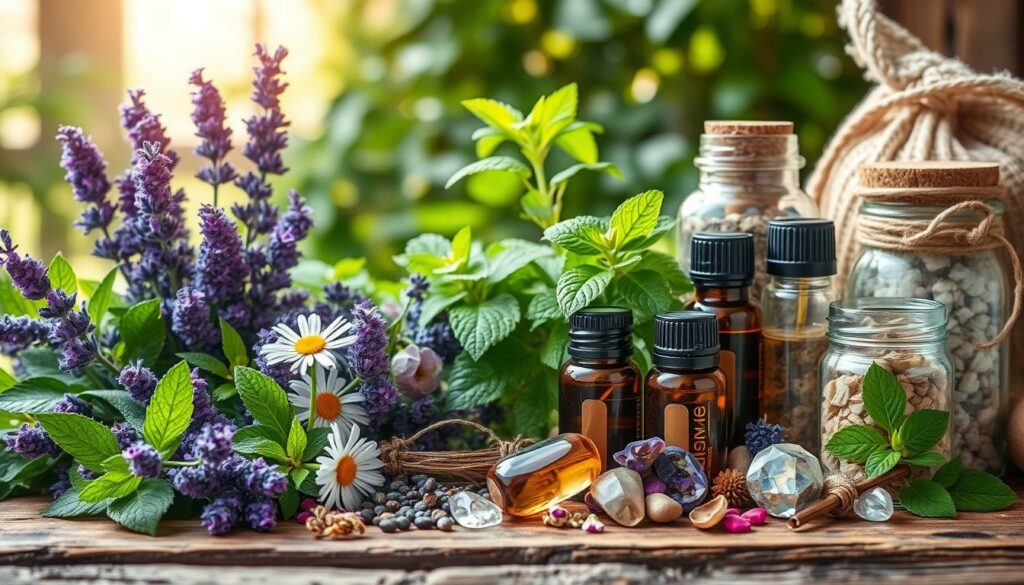In today’s fast world, we often feel overwhelmed. We seek balance and peace. Natural healing remedies help us feel whole, supporting our body, mind, and spirit.
Imagine starting each day feeling full of life and balance. These remedies help us find harmony in our lives.
Let’s explore holistic health solutions together. We’ll see how herbal remedies can change our lives. We’ll learn from ancient wisdom that connects us to the earth and our bodies.
Key Takeaways
- Natural healing remedies can enhance physical, mental, and emotional health.
- Holistic well-being focuses on nurturing the whole person.
- Incorporating herbal remedies can promote balance in our lives.
- Ancient practices provide valuable insights into modern health solutions.
- Staying connected to nature enhances our overall well-being.
The Essence of Holistic Well-Being
Holistic well-being is about the connection between our mind, body, and spirit. It’s a way to look at health from a complete perspective. By understanding this mind-body connection, we see how different parts affect our overall health.
Creating a balanced lifestyle means taking care of our emotions, body, and spirit. This leads to the best health possible.
Choosing a holistic approach brings many benefits. For instance, having strong social ties can lower blood pressure by 10-20%. It also cuts down stress levels a lot. This shows that good relationships are key to our well-being.
Practices like mindfulness and regular exercise are also important. Mindfulness meditation can cut anxiety by 40-50%. It helps us stay mentally clear and emotionally balanced.
Doing activities like brisk walking and yoga boosts our physical health. They also help our lymphatic system, which is good for detox and energy.
Our path to holistic well-being is a journey of making healthy choices. Small changes, like eating whole foods and getting enough sleep, can make a big difference. As we make these choices, we gain more energy, feel better, and handle chronic conditions better.
Understanding Holistic Health Solutions
When we talk about holistic health, we mean treating the whole person. This includes the body, mind, spirit, and emotions. It’s not just about fixing symptoms but finding the real cause of health problems.
Many people are looking for natural ways to feel better. In fact, about 50% of U.S. adults use holistic methods along with traditional medicine.
Many holistic practitioners have a lot of education. Doctors of osteopathy and naturopathic doctors have degrees from accredited schools. Chiropractic doctors and those in traditional Chinese medicine also have a lot of training. This shows how serious holistic health is about providing good care.
Natural remedies are key in holistic wellness. They are often cheaper than traditional medicines. This makes them appealing to those looking for affordable health options.
We also focus on making lifestyle changes and reducing stress. Studies show that when people learn about health, they can take better care of themselves. This can lead to better eating, more exercise, and a happier life.
Understanding how physical, emotional, and mental health are connected is important. This helps us see the value of holistic health solutions.
| Holistic Practitioner Types | Education Requirements |
|---|---|
| Naturopathic Doctors (NDs) | Graduated from licensed naturopathic medical schools |
| Chiropractic Doctors (DCs) | Minimum of four years post-graduate training at an accredited college |
| Doctors of Osteopathy (DO) | Complete medical training with a focus on holistic care |
| Traditional Chinese Medicine Practitioners | 3 to 4 years of study at accredited institutions |
The Power of Natural Healing Remedies
Exploring natural healing remedies opens a door to where old wisdom meets new science. We see how home remedies help across cultures, like fighting colds and reducing inflammation. Research shows how natural ingredients can improve our health in many ways.
The Science Behind Home Remedies
Home remedies have been around for a long time, showing a deep understanding of health. Studies say about 70% of people with chronic illnesses use natural remedies along with doctor’s treatments. These remedies often include eating right and changing our lifestyle to boost health.
About 90% of naturopathic doctors suggest eating better to help our bodies heal. This mix of old and new ways helps us stay healthy. Around 70% of people using natural remedies see big improvements in their health.
Research-Backed Herbal Solutions
Herbal solutions are becoming more important in today’s health care. Research shows they make up about 30% of the alternative medicine market. For example, ginger and turmeric are popular for their health benefits.
Studies show 70% of people using ginger feel better from nausea, which is great for those going through chemotherapy. Almost 65% of people with arthritis or digestive problems use turmeric for its anti-inflammatory effects. This shows how herbal solutions can really help us feel better.
| Herbal Solutions | Usage Percentage | Benefits |
|---|---|---|
| Chamomile | 25% | Calming effects, relief from anxiety and sleep disorders |
| Echinacea | 50% | Boosts immune system, prevents colds and infections |
| Ginger | 70% | Relief from nausea and digestive issues |
| Turmeric | 65% | Anti-inflammatory properties for arthritis and digestive health |
| Essential Oils | 40% | Therapeutic benefits for various ailments |

By using natural healing remedies, we can manage and improve our health. The evidence supports their effectiveness. It’s not just a choice; it’s a commitment to our overall well-being.
Exploring Alternative Medicine Practices
In recent years, more people are interested in alternative medicine. This interest helps us find new ways to improve our health. It combines physical and mental health, showing a new way to see health care.
Studies show that more Americans are trying alternative medicine. In 1990, 33.8% tried it, and by 1997, that number jumped to 42.1%. Prayer, herbalism, and breathing meditation are among the most popular. These numbers show how big a part alternative medicine plays in our health journey.
Acupuncture is well-known for helping with pain. It uses needles to improve energy flow, or qi. Chiropractic care is also popular for relieving muscle pain, helping us feel better.
Ayurveda focuses on a balanced life through diet and exercise. It aims to balance the body’s energies. Naturopathy uses natural remedies like herbal medicine to help us heal and feel better.
Yoga and meditation are great for our minds. They help lower anxiety and depression. This shows how our body and mind are connected, a key part of alternative medicine. Many people use these therapies along with traditional medicine.
In short, exploring alternative medicine helps us understand wellness better. It offers new ways to care for our health, aiming for a balanced and happy life.
Top Herbal Remedies for Wellness
We often look to nature for holistic well-being. Turmeric and ginger are key for their health benefits. Each herb supports our bodies and boosts our health.
Turmeric: The Golden Spice
Turmeric, called the “golden spice,” has been valued for centuries. It fights inflammation and pain thanks to curcumin. It’s great for many health issues, making turmeric a top choice for wellness.
Adding turmeric to meals or taking supplements is easy. It’s a simple way to improve your health.
Ginger: A Natural Anti-Inflammatory
Ginger is another powerful herb for health. It’s known for its anti-inflammatory effects and helps with nausea. You can use ginger in cooking, tea, or supplements.
Ginger’s long history and benefits make it a key part of natural medicine.
Homeopathic Healing Techniques
Homeopathy is an interesting alternative therapy based on “like cures like.” It uses substances that cause symptoms in healthy people to treat similar symptoms in the sick. It started in Germany in the late 1700s and became popular in many European countries. But it is less common in the United States.
Exploring homeopathic healing, we find natural substances used as remedies. For example, red onion helps with allergies and poison ivy. Other examples include white arsenic, crushed whole bees, and arnica. These show the wide range of natural materials used.
Practitioners use a process called “potentization” to prepare these remedies. They dilute substances with water or alcohol. This process might keep their healing properties. It’s interesting that many remedies are so diluted they might not have much of the original substance left.

Homeopathic remedies come in different forms like sugar pellets, liquid drops, creams, gels, and tablets. They help with many health issues, from chronic diseases to minor problems like bruises and toothaches. The FDA oversees manufacturing but doesn’t check if these remedies are safe or work well.
Some studies suggest homeopathy might help with symptoms of asthma and fibromyalgia. This could improve the lives of those who use it. But, many are still unsure if homeopathy really works. There’s a lot of debate about its effectiveness in natural health.
Traditional Healing Methods Across Cultures
Exploring traditional healing methods shows how cultures have used natural remedies for ages. Each culture has its own way of looking at health and wellness. For example, Ayurveda from India focuses on balancing the body through diet, herbs, and yoga.
Its ancient texts, like the Charaka Samhita, show deep understanding of health. They talk about treating and preventing illnesses.
Chinese medicine also plays a big role with acupuncture and herbs. These methods help balance the body’s energy. They are now part of our modern healthcare.
Shamanism, with roots over 30,000 years old, connects people with nature. It offers a spiritual view on health and healing.
More and more, the world is recognizing these healing ways. Reports say 170 WHO Member States use global wellness practices in healthcare. Mixing traditional healing with modern medicine helps us understand health better.
This mix also helps everyone get the right treatment. It shows the value of traditional knowledge and promotes health for all.
Here is a table summarizing key traditional healing methods and their foundational principles:
| Culture | Healing Method | Principles |
|---|---|---|
| Indian (Ayurveda) | Herbal Remedies | Balancing bodily systems; holistic health |
| Chinese | Acupuncture | Restoring energy flow; meridian theory |
| Indigenous | Shamanism | Spiritual connection to nature; healing rituals |
| Western | Homeopathy | Like cures like; individualized treatment |
| Ancient Egyptian | Surgical Techniques | Documentation of medical knowledge |
Integrative Medicine Therapies for Balance
In our search for well-rounded wellness, we must explore integrative medicine therapies. These therapies combine traditional and alternative approaches. They form a complete framework for our health. By seeing the connection between body and mind, we find healing paths that traditional medicine might miss.
About 38% of adults in the U.S. use complementary and alternative medicine (CAM). This shows more people are looking for different healing ways. Acupuncture is very popular, helping with pain and discomfort, like in cancer patients.
These therapies look at each person’s unique situation. Yoga therapy helps with stress and improves physical flexibility. Dietary and herbal approaches fix nutritional gaps that cause chronic diseases, adding a key piece to the wellness puzzle.
- Body therapies, like chiropractic and massage, aim to balance and connect the body.
- Mind practices, such as meditation and hypnosis, show the mind’s role in health.
- Sensory therapies, like art and music, use our senses to heal.
Integrative medicine helps not just adults but also children, with about 12% using CAM. By adding these holistic methods to our lives, we care for our bodies and minds. We seek balance in a busy world. These methods show wellness is more than just not being sick; it’s a vibrant state of being, reached by combining different health approaches.
Holistic Healing Approaches for Mental Clarity
We explore holistic healing methods that boost mental clarity and emotional balance. There are over 100 holistic practices to choose from. The National Center for Complementary and Integrative Health lists five main categories, including mind-body and energy therapies. Each offers unique benefits for a more peaceful life.
Techniques like mindfulness, meditation, and yoga are key for reducing stress and improving thinking. They help us stay calm and focused, ready to tackle challenges. Not getting enough sleep can lead to health problems, showing how important rest is for our well-being.
A holistic approach looks at our whole being: mind, body, emotions, spirit, and social connections. It’s about living a balanced life with exercise and healthy food. Our gut and brain are connected, affecting our mood and thinking, making nutrition crucial for emotional health.
Having strong social connections can reduce stress and improve our lives. Bad social relationships can harm our health, like obesity and lack of exercise. Being in nature, whether gardening or just enjoying the outdoors, also boosts mental clarity.
Art, recreational, and music therapies help with self-esteem, solving problems, and expressing feelings. These holistic methods tap into our deep need for meaning and purpose, helping us feel better mentally.
Using holistic healing methods can help with common mental health issues. Mental disorders affect nearly 1 in 5 adults. By using these techniques, we can improve our mental health and find lasting emotional balance.
Conclusion
Looking back, we see that holistic well-being is more than just an idea. It’s a real, achievable goal. By using the natural healing remedies and practices we’ve learned, we can start a journey towards better health and happiness. Exploring herbal remedies and traditional healing shows us how to live a balanced life.
Herbal education, like the work of Ms. Bellebuono, shows our growing interest in natural healing. As more people choose complementary therapies, we see a blend of old and new in health care. We invite you to keep exploring these natural remedies and stay updated on our wellness journey.
Let’s keep growing and empowering ourselves in the world of holistic well-being. By understanding both traditional and modern treatments, we can make better health choices. This leads to a future filled with health, vitality, and joy.
